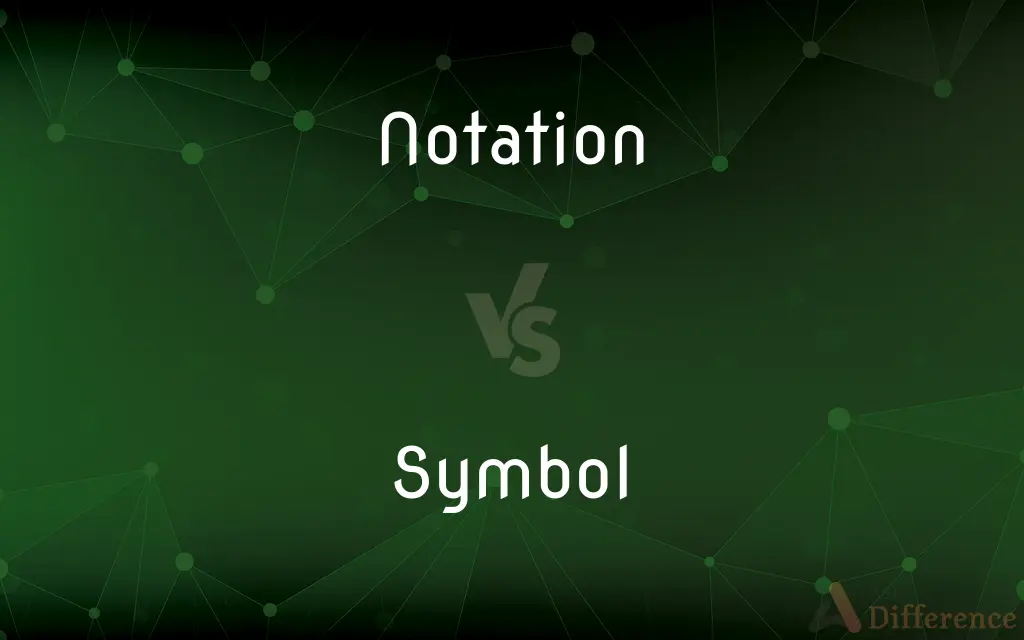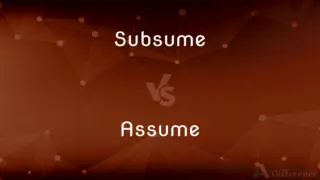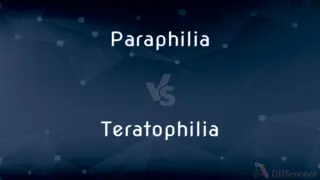Notation vs. Symbol — What's the Difference?
By Tayyaba Rehman & Fiza Rafique — Updated on March 7, 2024
Notation involves a system of symbols or signs for representation, focusing on rules and contexts, whereas a symbol is a singular representation that stands for an idea, object, or relationship without explicit rules.

Difference Between Notation and Symbol
Table of Contents
ADVERTISEMENT
Key Differences
Notation is a systematic method of using symbols or signs to represent information, ideas, or processes in various fields, such as mathematics, music, and computer science. It follows specific rules and conventions to convey complex information clearly and efficiently. On the other hand, a symbol is a singular entity that can represent an idea, object, process, or relationship in a more abstract and often cultural or contextual manner. Symbols do not necessarily follow a set of rules and can convey meanings that are interpreted differently based on cultural, societal, or individual perspectives.
Notations are essential for precise communication within specific domains. They allow complex ideas to be expressed concisely and unambiguously, enabling professionals and scholars to understand and build upon each other's work. Whereas symbols, being more versatile and subjective, play a significant role in expressing cultural values, emotions, and identities. They can evoke deep meanings and associations without the need for explicit explanation.
In mathematics, notation like "x^2" clearly defines the operation of squaring the variable x, adhering to universally accepted mathematical principles. While in the same context, a symbol like π represents the ratio of a circle's circumference to its diameter, a specific value that transcends its mathematical definition to convey ideas of circularity, infinity, and perfection in various cultural contexts.
Notation often requires learning and familiarity with the specific field's language to be understood correctly. It is part of a larger system where each sign or symbol functions within agreed-upon parameters. Symbols, however, can be more immediately impactful and require less specialized knowledge to evoke a response or convey a message, relying on shared cultural or social understandings.
While notation is critical for the accuracy and advancement of scientific, mathematical, and technical fields, symbols are pivotal in arts, literature, and communication, reflecting human experiences, emotions, and social complexities. Both play indispensable roles in human understanding and expression, yet they operate in distinctly different realms of communication and interpretation.
ADVERTISEMENT
Comparison Chart
Definition
A system of symbols or signs with specific rules for representation.
A singular representation that stands for an idea, object, or relationship.
Purpose
To convey complex information efficiently and unambiguously.
To evoke ideas, emotions, or associations.
Context
Used in specialized fields like mathematics, music, and science.
Found in broader cultural, societal, and individual contexts.
Interpretation
Requires understanding of the specific system's rules.
Can be interpreted differently based on cultural or individual perspectives.
Examples
Mathematical equations, musical scores, chemical formulas.
Religious icons, national flags, emojis.
Compare with Definitions
Notation
A way to represent chemical compounds and reactions.
Chemical notation such as H2O makes it easy to identify water molecules.
Symbol
An object that stands for or suggests something else by reason of relationship.
A chain can symbolize unity or connection.
Notation
A system used in computer programming to denote functions and commands.
The programmer used precise notation to debug the software efficiently.
Symbol
A graphical icon used in computing and digital interfaces.
The trash can symbol is universally recognized as delete or remove.
Notation
A method of writing music to represent rhythm, pitch, and tempo.
The sheet music contained complex notation that only experienced musicians could interpret.
Symbol
A sign used in writing and printing to represent operations or values.
The plus symbol (+) signifies addition in mathematics.
Notation
The representation of linguistic sounds with phonetic symbols.
Phonetic notation helps linguists accurately study and compare languages.
Symbol
A character used to represent an idea or concept.
The dove is a symbol of peace in many cultures.
Notation
The use of symbols in mathematics to express numbers and operations.
In algebra, notation like 2x + 3 = 7 is used to solve for unknown variables.
Symbol
A figure or character used in religious or spiritual contexts.
The cross is a central symbol in Christianity.
Notation
In linguistics and semiotics, a notation is a system of graphics or symbols, characters and abbreviated expressions, used (for example) in artistic and scientific disciplines to represent technical facts and quantities by convention. Therefore, a notation is a collection of related symbols that are each given an arbitrary meaning, created to facilitate structured communication within a domain knowledge or field of study.
Symbol
A symbol is a mark, sign, or word that indicates, signifies, or is understood as representing an idea, object, or relationship. Symbols allow people to go beyond what is known or seen by creating linkages between otherwise very different concepts and experiences.
Notation
A series or system of written symbols used to represent numbers, amounts, or elements in something such as music or mathematics
Algebraic notation
New terminologies and notations
Symbol
A mark or character used as a conventional representation of an object, function, or process, e.g. the letter or letters standing for a chemical element or a character in musical notation
The chemical symbol for helium is He
The symbol r in Figure 5 represents a gene which is ineffective
Notation
A note or annotation
He noticed the notations in the margin
Symbol
A thing that represents or stands for something else, especially a material object representing something abstract
The limousine was another symbol of his wealth and authority
Notation
Short for "scale of notation" (see scale)
Symbol
Symbolize.
Notation
A system of figures or symbols used in a specialized field to represent numbers, quantities, tones, or values
Musical notation.
Symbol
Something that represents something else by association, resemblance, or convention, especially a material object used to represent something invisible
The lamb is a symbol of innocence.
Notation
The act or process of using such a system.
Symbol
An instance that typifies a broader pattern or situation
His striking out to end the rally was a symbol of everything that had gone wrong with the team over the past month.
Notation
A brief note; an annotation
Marginal notations.
Symbol
A printed or written sign used to represent an operation, element, quantity, quality, or relation, as in mathematics or music.
Notation
(uncountable) The act, process, method, or an instance of representing by a system or set of marks, signs, figures, or characters.
Symbol
(Psychology) An object or image that an individual unconsciously uses to represent repressed thoughts, feelings, or impulses
A phallic symbol.
Notation
(uncountable) A system of characters, symbols, or abbreviated expressions used in an art or science or in mathematics or logic to express technical facts or quantities.
This section lists all algebraic notation used in this book. (Using notations would be incorrect).
The notations used in the two books differed. (Using notation would be incorrect).
Symbol
A character or glyph representing an idea, concept or object.
$ is the symbol for dollars in the US and some other countries.
Chinese people use word symbols for writing.
Notation
(countable) A specific note or piece of information written in such a notation.
She made a notation in the margin of the book.
Symbol
A thing considered the embodiment of a concept or object.
The lion is the symbol of courage; the lamb is the symbol of meekness or patience.
Notation
The act or practice of recording anything by marks, figures, or characters.
Symbol
(linguistics) A type of noun whereby the form refers to the same entity independently of the context; a symbol arbitrarily denotes a referent. See also icon and index.
Notation
Any particular system of characters, symbols, or abbreviated expressions used in art or science, to express briefly technical facts, quantities, etc.
Symbol
A summary of a dogmatic statement of faith.
The Apostles, Nicene Creed and the confessional books of Protestantism, such as the Augsburg Confession of Lutheranism are considered symbols.
Notation
Literal or etymological signification.
"Conscience" is a Latin word, and, according to the very notation of it, imports a double or joint knowledge.
Symbol
(crystallography) The numerical expression which defines a plane's position relative to the assumed axes.
Notation
A technical system of symbols used to represent special things
Symbol
(obsolete) That which is thrown into a common fund; hence, an appointed or accustomed duty.
Notation
A comment or instruction (usually added);
His notes were appended at the end of the article
He added a short notation to the address on the envelope
Symbol
(obsolete) Share; allotment.
Notation
The activity of representing something by a special system of marks or characters
Symbol
(programming) An internal identifier used by a debugger to relate parts of the compiled program to the corresponding names in the source code.
Symbol
(telecommunications) A signalling event on a communications channel; a signal that cannot be further divided into meaningful information.
Symbol
To symbolize.
Symbol
A visible sign or representation of an idea; anything which suggests an idea or quality, or another thing, as by resemblance or by convention; an emblem; a representation; a type; a figure; as, the lion is the symbol of courage; the lamb is the symbol of meekness or patience.
A symbol is a sign included in the idea which it represents, e. g., an actual part chosen to represent the whole, or a lower form or species used as the representative of a higher in the same kind.
Symbol
Any character used to represent a quantity, an operation, a relation, or an abbreviation.
Symbol
An abstract or compendium of faith or doctrine; a creed, or a summary of the articles of religion.
Symbol
That which is thrown into a common fund; hence, an appointed or accustomed duty.
They do their work in the days of peace . . . and come to pay their symbol in a war or in a plague.
Symbol
Share; allotment.
The persons who are to be judged . . . shall all appear to receive their symbol.
Symbol
An abbreviation standing for the name of an element and consisting of the initial letter of the Latin or New Latin name, or sometimes of the initial letter with a following one; as, C for carbon, Na for sodium (Natrium), Fe for iron (Ferrum), Sn for tin (Stannum), Sb for antimony (Stibium), etc. See the list of names and symbols under Element.
Symbol
To symbolize.
Symbol
An arbitrary sign (written or printed) that has acquired a conventional significance
Symbol
Something visible that by association or convention represents something else that is invisible;
The eagle is a symbol of the United States
Common Curiosities
What is notation used for?
Notation is used to systematically represent complex information or ideas, especially in specialized fields such as mathematics, science, and music.
Why are symbols important in culture?
Symbols are crucial for expressing and conveying cultural values, beliefs, emotions, and identities.
How does one learn notation?
Learning notation typically requires study and familiarity with the specific language and rules of the field it is used in.
Can a symbol be a part of notation?
Yes, symbols can be part of notations as elemental components used to construct more complex representations following specific rules.
Is a symbol the same as a logo?
A logo can be considered a type of symbol, specifically designed to represent and identify a brand or organization.
How do symbols affect communication?
Symbols enrich communication by enabling concise and powerful conveyance of ideas and emotions beyond the limitations of language.
Do symbols have fixed meanings?
The meanings of symbols can evolve and vary between different cultures and over time.
Are symbols universally understood?
While some symbols have near-universal recognition, many are interpreted differently based on cultural, societal, or individual contexts.
Can notation change over time?
Yes, notations can evolve as the associated fields develop and as consensus on conventions shifts.
Are there universal notations?
Some notations, like mathematical or musical notations, are widely recognized and used globally.
How do symbols play a role in branding?
In branding, symbols serve as visual identifiers that convey the essence and values of a brand.
What is the difference between an icon and a symbol?
An icon is a specific type of symbol that visually represents an object, action, or idea in a more literal way.
What makes a good notation system?
Clarity, consistency, and the capacity to represent complex ideas efficiently make a good notation system.
Can notation be considered a language?
Yes, notation can be considered a specialized language designed for precise communication within specific domains.
Can everyone interpret symbols the same way?
No, the interpretation of symbols is often subjective and can vary widely among different people.
Share Your Discovery

Previous Comparison
Subsume vs. Assume
Next Comparison
Paraphilia vs. TeratophiliaAuthor Spotlight
Written by
Tayyaba RehmanTayyaba Rehman is a distinguished writer, currently serving as a primary contributor to askdifference.com. As a researcher in semantics and etymology, Tayyaba's passion for the complexity of languages and their distinctions has found a perfect home on the platform. Tayyaba delves into the intricacies of language, distinguishing between commonly confused words and phrases, thereby providing clarity for readers worldwide.
Co-written by
Fiza RafiqueFiza Rafique is a skilled content writer at AskDifference.com, where she meticulously refines and enhances written pieces. Drawing from her vast editorial expertise, Fiza ensures clarity, accuracy, and precision in every article. Passionate about language, she continually seeks to elevate the quality of content for readers worldwide.














































